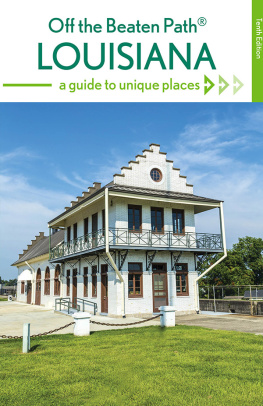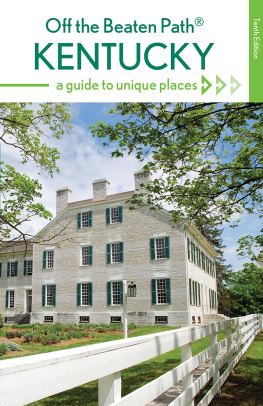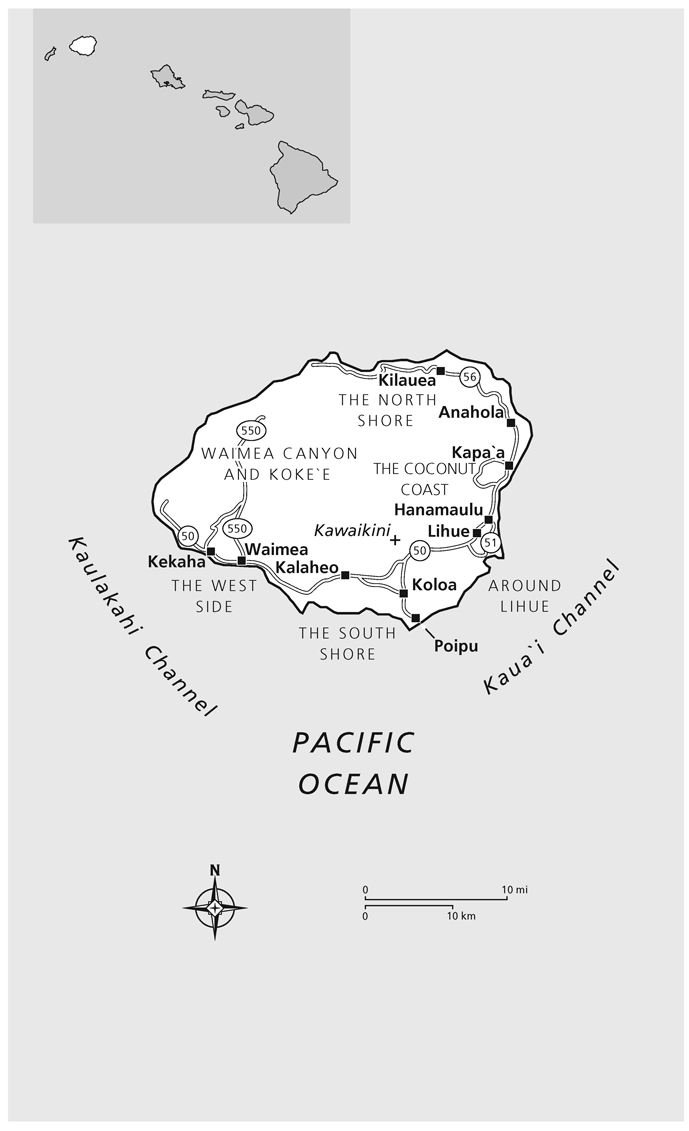About the Author
Sean Pager first came to Hawaii at the age of six months. It didnt make much of an impression at the time, but he enjoyed growing up in the islands and appreciated them even more when he continued to travel and live elsewhere. Sean did his first paid travel writing for the Lets Go series as a summer job while in college and liked it enough to stick with it after graduation. Hawaii: Off the Beaten Path is his first book-length publication. In his free time, Sean likes to go off the beaten path in the islands by hiking the hills or sailboarding the coast. He currently lives with his wife, Sheryl, and daughter, Sophie.
Kaua`i stands apart from the other islands of Hawaii. The farthest north of the main islands, Kaua`i is the oldest geologically. Six million years have given erosive forces the time to sculpt its mountain slopes with a delicate scalpel. An eternity of waves has wreathed the island in a white lei of sand. Kaua`i is also the wettest Hawaiian island. Its central peak, Mount Wai`ale`ale (overflowing waters), holds the worlds record for annual rainfall. The overflowing waters from such constant precipitation feed Kaua`is seven full-fledged rivers, where other islands have mere streams. The unrivaled lushness of this Garden Island has lured Hollywood here to film countless motion pictures, including Jurassic Park and Raiders of the Lost Ark.
Kaua`i has always stood apart in human terms as well. The Kaua`i Channel is wider, deeper, and rougher than those between other islands. Scientists think Kaua`i and its nearest neighbor, Niihau, remained fairly isolated in ancient Hawaii. These were the only islands Kamehameha did not conquer. Two invasion fleets failed, one beaten back by storms, the next devastated by sickness. In the end, Kaua`is King Kaumualii voluntarily acknowledged Kamehamehas sovereignty, but the islands remained a separate kingdom until his death.
KAUA`I
Two main highways, Kaumualii (Route 50) and Kuhio (Route 56), reach like arms around the island, with a third main roadway branching off Route 50 to climb the inland heights of Koke`e State Park. Starting from Lihue, the central town, you can drive slightly more than 40 miles in each direction before running into the impassable barrier of the Na Pali Coast. Throughout your stay on Kaua`i, look for the Sunshine Farmers Markets that rotate through the island towns six days a week. They combine local color with real bargains. Check online at www.kauai.gov for the current schedule.
facts
Nickname: Garden Isle
Dimensions: 32 25 miles
Highest elevation:
Mt. Kawaikini (5,243 feet)
Population: 63,689 (2008)
Principal city: Lihue
Flower: Mokihana
Color: Purple
A great way to go off the beaten path on Kaua`i is by paddling a kayak. Even novices can safely navigate the islands rivers to reach secluded waterfalls. Experienced ocean paddlers can explore sections of otherwise inaccessible coastline. Several local firms rent kayaks and supply racks to transport them. Outfitters Kaua`i (742-9667; 888-742-9887; www.outfitterskauai.com) in Poipu also rents bikes and leads hiking, biking, and kayaking tours. They have a permit for tours in Waimea Canyon and Koke`e and can supply detailed route maps for suggested activities. Kayak Kaua`i (826-9844 in Hanalei; 800-437-3507; www.kayakkauai.com) offers similar services on the North Shore and Coconut Coast.
Ecologist Dr. Carl Berg offers custom hiking tours tailored according to interest and ability at very reasonable rates. Call Hawaiian Wildlife Tours (639-2968; www.hawaiianwildlifetours.com). In addition, look in the local paper for listings of the Kaua`i Sierra Clubs bimonthly outings. If hiking is out, contact Aloha Kaua`i Tours (245-6400; 800-452-1113; www.alohakauaitours.com). The air-conditioned vans allow passengers to see some of the islands scenic backcountry without the burden of sore feet. Half-day tours include your choice of a rain-forest hike, a snorkeling trip, and a back-roads adventure. Fees start at $75. While planning your stay, contact the Kauai Visitors Bureau (245-3971; 800-262-1400; www.kauaidiscovery.com).
Around Lihue
Located on the southeastern corner of Kaua`i, Lihue serves as the county seat, the main air and sea port, and the midpoint from which highway mileage is numbered. Surrounded by sugarcane and hemmed in on all sides by mountains, Lihue town is relatively new as a settlement. The ancient Hawaiians usually bypassed this section of the coast, following instead an inland route behind the mountains. Sugar, centrality, and proximity to O`ahu conspired to put Lihue on the map. Recent tourist developments favoring other coasts have had the opposite effect.
trivia
There are more miles of beach per coastline here than on any other island.
By law, no building here can be taller than a palm tree.
Kaua`i hosts the largest coffee plantation in Hawaii.
Kaua`is Mount Wai`ale`ale is the wettest spot on earth.
Wailua River is the only navigable river in Hawaii.
Kaua`is tropical beauty has been filmed in more than sixty Hollywood movies.
At the junction of the two main highways, turn into Lihue on Rice Street, named for an early manager of the Lihue Sugar Plantation. Almost immediately on your left, the Kaua`i Museum (245-6931; www.kauaimuseum.org) stands behind an imposing classical facade. The well-organized exhibits within cover the story of Kaua`i from many angles. You can see photos of Niihau (as close as most people will ever get), study a model Hawaiian village, rattle a gourd, read excerpts from Captain Cooks log on discovery day, and even take a video tour, shot by helicopter, of the islands remote interior. The museum is open Mon through Fri 9 a.m. to 4 p.m. and Sat 10 a.m. to 4 p.m. $10 admission fee. Guided tours are offered Tues through Fri at 10:30 a.m.
On the next block, the 1913 former County Building reposes in a stately, royal palm-lined park. The Kaua`i Historical Society (245-3373; www.kauaihistoricalsociety.org) has its office inside, with books on island history and self-guiding history maps for sale. Open weekdays from 8 a.m. to 4 p.m. You can get state camping permits (274-3444) from the State Building behind the old county building for $5 per night ($10 for Na Pali Coast). Permits for the countys excellent campgrounds (241-4463; www.kauai.gov) are issued for $3 per adult at the cylindrical county building at the top end of Rice Street. Permits can be issued for up to seven days and can be requested up to one year in advance. Haleko Road runs west off Rice Street just inland of the museum, directly behind the now-silent Lihue sugar mill. On the way down, notice the Haleko Shops on the right, near the corner. Severely damaged in the 1992 hurricane, these four concrete remnants and ornate marble horse trough came from a plantation housing camp for German workers.
As a side trip, you can find the Church of All Nations, which these devout immigrants built atop German Hill on the other side of the mill. (An HVCB marker points up Ho`omana Road from Route 50.) This 1885 Lutheran church has an attractive baroque altar inside. But look more closely. The floor is actually bowed like the deck of a ship, with the pulpit the elevated forecastle and the balcony the quarterdeck. The church design symbolizes not only the ship that carried these immigrants to their new home but also the ship of faith that sustained them on their voyage.






